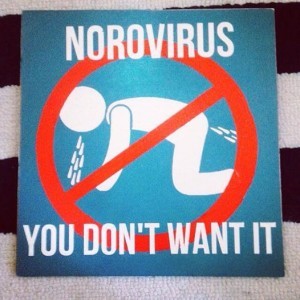My friend Miriam Meister writes that the risk of getting a foodborne infection from fresh fruit and vegetables in Denmark is highest from consumption of berries, lettuce, sprouts, tomato and melon. This is the finding of a risk ranking performed by the National Food Institute, Technical University of Denmark for the Danish Veterinary and Food Administration. The ranking can be used to prioritise initiatives aimed at strengthening food safety.
 Danes eat more fruit and vegetables then they used to. Consumption has increased from 1995-2013 by 30%. Danish consumers also have greater access to fresh produce from all over the world. At the same time fresh fruit and vegetables have increasingly been the cause of foodborne infections – not only in Denmark but in the entire industrialised world. As a consequence of the increased global trade there is a risk that disease-causing microorganisms, which were only rarely or never found in Denmark, are being introduced onto the Danish market through imported goods.
Danes eat more fruit and vegetables then they used to. Consumption has increased from 1995-2013 by 30%. Danish consumers also have greater access to fresh produce from all over the world. At the same time fresh fruit and vegetables have increasingly been the cause of foodborne infections – not only in Denmark but in the entire industrialised world. As a consequence of the increased global trade there is a risk that disease-causing microorganisms, which were only rarely or never found in Denmark, are being introduced onto the Danish market through imported goods.
This is the reason that the National Food Institute has evaluated the risk from microorganisms in ready-to-eat fresh fruit and vegetables on the Danish market. A list has been drawn up of combinations of products and disease-causing microorganisms, which pose the greatest risk of disease to Danish consumers. A total of 30 different combinations are included.
The ranking is based on an overall assessment of the risk posed by each of the 30 combinations. The assessment is based on data on the occurrence of microorganisms in the specific products, the dosage of the microorganism needed to cause disease, how severe a disease it causes, average number of cases per year, and how much of the specific product is eaten.
Norovirus in berries ranks highest, followed by salmonella, norovirus and E. coli in lettuce. In general, berries, lettuce, sprouts, tomatoes and melons are at the top of the ranking. The results are largely consistent with what similar European and American risk rankings have found.
The authorities can use the results to evaluate the effect of control measures and changing consumption patterns as well as to prioritise initiatives aimed at strengthening food safety.
For this project the National Food Institute has developed a tool that can be used to rank combinations of products and disease-causing microorganisms for groups of people with different consumption patterns. The tool can also be used to update the risk ranking when new control data is available.
Fresh fruit and vegetables can contain disease-causing microorganism e.g. if they have been watered or washed with contaminated water, or they have been harvested or handled by people who have inadequate hand hygiene. Consumers can minimise the risk of disease by washing produce thoroughly and by following any instructions related to heat treatment
Read more
See the entire report: Risikorangering af sygdomsfremkaldende mikroorganismer i frisk frugt og grønt (pdf – available in Danish only).
The project defines fresh fruit and vegetables as fresh, unprocessed, ready-to-eat fruit and vegetable products, which are typically eaten without any further heat treatment or processing by the consumer. Also included are baby corn and snow peas, which are sometimes eaten without heeding advice for heat treatment. Frozen berries, which have often been associated with outbreaks of disease, are also included.













